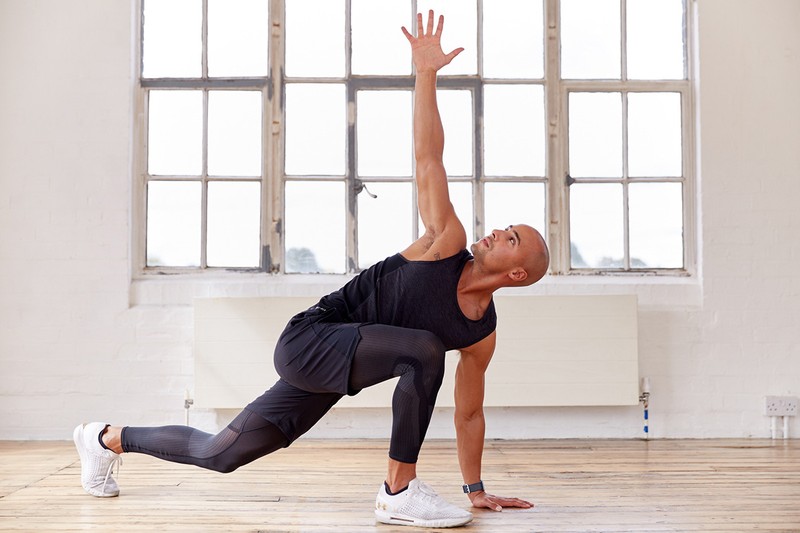My Fitness Rules: Omar Mansour
I train to be a better coach. It’s in everyone’s interests for me to get my training in – I just don’t perform at my best if I’m not mentally and physically in the zone. I currently train six times per week. I split this into three runs (one long run and two interval track sessions) as well as three strength sessions. My strength sessions focus predominantly on the whole body using compound moves such as squats, bench presses, chin ups and lunges. I always ensure I have at least one single leg (unilateral) move in a session too, which helps correct imbalances. This is particularly important if you are a keen runner. My favourite session is one that includes plenty of upper-body pushes and pulls – this gets a great pump on and leaves you feeling amazing.
Variety is important when it comes to running. I often switch up my running scenery to keep my body and mind stimulated. Some weekends, I travel down to Cornwall (restrictions permitting) to train on sand dunes, cliffs and trails. When I’m in London, I often head to Epping Forest, the track at Battersea or just hit the roads if I’m short on time. Every Monday evening I coach and jump into an interval track session with my running crew, Track Life LDN, down at Battersea, where the atmosphere is electric. If you enjoy training, you’re far more likely to stick to it – it’ll soon become playtime rather than just ‘training’. If you hate your training, it’s unlikely you’ll be consistent in the long run.
Don’t discard strength training. Resistance training is crucial, especially once you hit 40 when testosterone levels drop significantly. Strength training raises testosterone levels and will keep you feeling strong and energised as you age. In general, the average male responds well to two to three strength sessions per week, as well as one or two cardio workouts.
It pays to think about your technique. One of the most common mistakes men make in the gym is lifting weights that are too heavy with poor technique. As men, we often train with our egos and forget this isn’t the most effective way. It pays to slow down too, with studies showing slow-tempo training is more beneficial to building lean muscle mass.
Start steady. If you’re a fitness beginner or just getting back into the gym, take it easy. Men often get a wave of motivation in the new year and train too hard too soon, leaving them nowhere to go, or worse, they get injured. Instead, set clear, short-term measurable goals, which will help with motivation.
Master your mindset. Athletes have an incredibly resilient mindset, which helps them stay disciplined, even on the days they don’t feel up for it. Athletes are also clever with their programming and recovery, and know when to push hard.
Fitness can support your physical and mental health. Coming from a competitive sporting environment, I used to think training was about always getting better. While I still believe that, as I’ve got older I now realise the power that fitness has on the mind. One client in particular stands out to me – he came to me two years ago obese, with low confidence and low energy levels. Through consistent training over a six-month period, he completely transformed his body, losing two stone and gaining several kilos of lean muscle. He then went on to start his own business and found the girl of his dreams. He carried himself with a new confidence and it was clear it was the training that ignited this change – it was powerful stuff.
Stock up on creatine. You don’t need a cupboard full of supplements to help you reach your goals, but creatine can help. It’s one of the most researched supplements out there when it comes to building strength and lean muscle.

Don’t forget to warm up. Mobility matters more than ever right now, especially as we lead increasingly sedentary lifestyles with more of us working from home. A lack of movement forces our muscles and tendons to tighten and shorten over time, and incorporating mobility into your day can counteract this, reduce your risk of injury and allow you to train more effectively. Try to dedicate 15 minutes before every session to mobility and consider this your warm-up. Another easy way to fit mobility into your workout is to stretch during rest periods instead of just standing around – simple, but effective.
Consider getting a coach. Having direction can be useful in getting to your goals in the most efficient way. External feedback is also a great way to spot things you may have missed when it comes to technique. Personal recommendations are the best way to find a coach, but remember it’s a personal experience – just because a coach has the knowledge to get you to your goals, that doesn’t mean you’ll necessarily click with them. A good relationship with your coach is vital and your gut instinct is the best guide when it comes to finding a PT. If something feels off then it usually is. If you can’t afford a coach and want to improve your technique, go onto YouTube. There are so many tutorials that can help, especially with strength.
Cut out processed foods. I always encourage my clients to incorporate more vegetables into their diet and make sure they’re getting enough variety. Be sure to fuel your workouts too, both before and after. My go-to pre-training snack is peanut butter on toast with slices of banana – a great source of carbs, protein and healthy fats. Post-training, try smashed avocado on toast with a poached egg, chilli flakes, sundried tomatoes and a squeeze of fresh lime juice.
OMAR’S GOLDEN RULES FOR A BETTER MIND & BODY...
Train Hard, Recover Smarter
Remember that adaptations are made in your recovery. Nail your sleep and nutrition to support your training goals. Aim for at least seven to eight hours’ sleep every night.
Be Realistic
Can you actually fit in six sessions a week? Be sensible – think about the workouts you can genuinely fit into your week and stay consistent.
Mix It Up
Try to adapt your training every four to six weeks. This will keep you stimulated and avoid you reaching a plateau.
Know Your Body
Know when to push hard and when to scale back. Consider other stressors in your life, such as work and relationship stress, which can take their toll on your energy levels. Always adjust your sessions to reflect your energy levels.
Set Goals
Don’t just say you want to get stronger. Instead, set measurable goals – for example, pick an exercise and give yourself a time period in which you want to see improvements.
Have An Open Mind
Be open to learn. Just because you know a bit about the gym doesn’t mean you know it all. Learn from experts in the field and don’t be afraid to try new ways.
Visit OmarMansour.co.uk
DISCLAIMER: We endeavour to always credit the correct original source of every image we use. If you think a credit may be incorrect, please contact us at [email protected].


